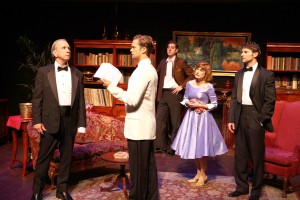Red Room illustrates family dynamics
Even though Christopher Knopf’s The Red Room takes place in Hollywood’s Golden Age, the family tensions it explores are timeless.

Family drama · Brad Blaisdell (left), Lane Compton, Chad Coe, Janet Fontaine and Rob Arbogast star in Chrisopher Knopf’s new play The Red Room. The show runs at the NoHo Arts Center until Sunday, Oct. 28. – | Photo courtesy of Rhett Benz
The NoHo Arts Center Ensemble tackles the challenging and realistic family drama, The Red Room, with aplomb. James J. Mellon and Brad Blaisdell have been with the NoHo ACE since its inception in 2004 and their vision continues to govern the company, bringing theater for its own sake to North Hollywood.
Acclaimed writer Christopher Knopf penned The Red Room as a semi-personal account of his family life set in the historical context of 1940s Hollywood. This adds a rich layer of history to the already compelling plot and makes the family’s problems more tangible. The time period also grounds the play, and characters pepper their speech with relevant and historically accurate names and references, adding a detailed sense of time and mood.
The intricate stage setting makes the audience truly believe they have wandered into the family’s sitting room. Costumes and settings add to the lavish ambiance of the time and can almost make viewers forget that they are not actually part of the family. Genuine visuals, coupled with the authentic dialogue, make the play believable and unapologetically human.
As the father, Edwin, Brad Blaisdell skillfully portrays his character in a way that allows the audience to sympathize with him. Edwin is a one-hit-wonder industry man who has trouble accepting his time in the limelight might be coming to an end. He spends beyond his means and resorts to alcohol in an effort to relive his glory days. Instead of celebrating his achievements, he is plagued by the ghosts of his past and feelings of inadequacy handed down to him from his father. Similarly to Shakespeare’s King Lear, Edwin is an aging monarch; he is not ready to relinquish his power. He seeks to live vicariously through his children by pressuring them to follow in his footsteps.
Despite the fact that she might not always agree with Edwin, his wife, Rose (Janet Fontaine), stands by his side. Although Rose represents a stereotypically submissive wife, Fontaine brings life to her character. She seeks to “weather the storm” while trying to keep the family together. Rose’s tenderness and maternal charm calls attention to the schism within the family; at times, her sweetness and earnestness in the face of bitterness and anger provides a painful contrast. Though her character does not include the backstory that Edwin’s does, viewers are still able and eager to sympathize with her.
The three sons are less prominent than Edwin and Rose, but add interesting subplots and color to the play. David (Chad Coe) work in the industry and share their complicated and checkered pasts. Though these characters could benefit from further development, the roles they play in the family dynamic are adequate and relatable.
It is the youngest son who has the most intricate character of the three boys. Near the end of the play, the youngest son, Johnny (Lane Compton) says, “In college you learn who others are,” but he needs to pursue his own dreams to learn who he is. This search for identity remains especially relevant to students and young adults. His visible clash with Edwin over life choices reinforces the ideas of inadequacy and living up to parental expectations. There is neither a clear-cut answer to the questions posed nor a resolution between father and sons. Ambiguity and silence provide a harshly real, if somewhat unsatisfying conclusion.
The play’s use of silence serves to highlight key actions as well as build the tension between family members and competing ideologies. Some of the most important actions take place in complete silence. This places a premium on the actors’ movements and draws the audience deeper into the emotions of the family. Yet, timely music also plays an important role in transitioning between flashbacks and the present. Though the music lacks variation, it seems to be a purposeful and stylistic choice, which mirrors how the main characters are caught in one place and time.
The dynamic family interactions, facilitated by the tasteful casting, bring The Red Room’s themes to life. Actors and students alike will be able to find themselves in the character’s struggles for identity, approval and success. Unlike a television show that can be turned off or tuned out, The Red Room will leave an impact on audiences through its thoroughly human portrayal of family tensions.
The Red Room is showing through Sunday, Oct. 28 at the NoHo Arts Center, located on 11136 Magnolia Blvd. in North Hollywood.
